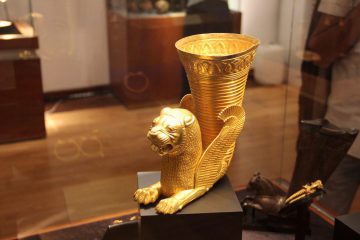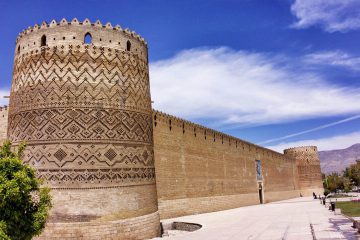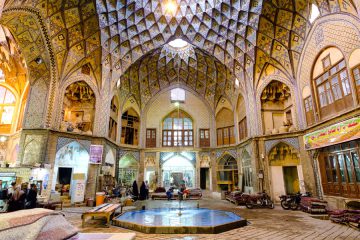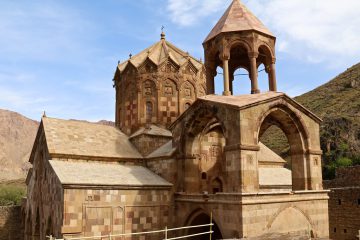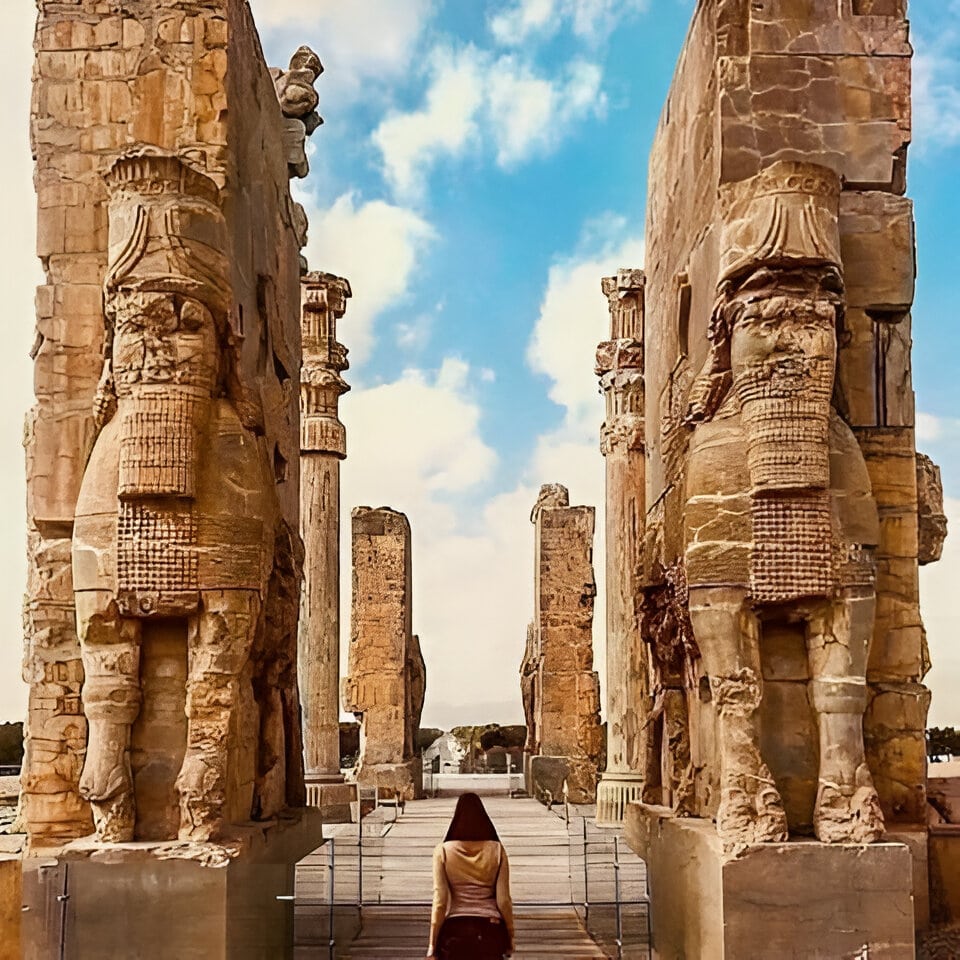
The Gate of All Nations
Welcome to the enchanting world of Persepolis, where history comes alive amidst the ancient ruins. In this article, we invite you to discover the Gate of All Nations, a remarkable architectural marvel that once marked the grand entrance to this ancient city.
As you step through the gate, you’ll be transported back to the glory days of the Achaemenid Empire, which flourished over 2,500 years ago. The Gate of All Nations, also known as the Xerxes Gate, symbolized power and majesty, greeting travelers from all corners of the empire.
Adorned with intricate carvings and towering columns, the gate is a testament to its creators’ rich artistic and engineering prowess. The imposing stone reliefs depict mythical creatures and royal symbols, offering a glimpse into the grandeur of the Persian civilization.
Today, the Gate of All Nations stands as an enduring testament to the legacy of Persepolis. It is a place where visitors can not only marvel at the skill of ancient architects but also connect with the rich history of a once-great empire. Join us on this journey of exploration as we uncover the secrets behind this awe-inspiring gateway.
Historical significance of the Gate of All Nations
The Gate of All Nations holds immense historical significance as it was the main entrance to Persepolis’s royal complex, the Achaemenid Empire’s ceremonial capital. Built during the reign of King Xerxes I, the gate served as a symbol of authority and power. Through this magnificent gateway, emissaries, visitors, and tribute bearers from different regions of the vast empire would enter, paying homage to the king.
The gate was a physical entrance and represented a political and cultural threshold. It showcased the empire’s diversity, with its massive stone columns adorned with carvings of figures representing the various nations under Persian rule. These carvings testify to the Achaemenid Empire’s ability to unite and govern a vast territory.
The Gate of All Nations also played a crucial role in diplomatic relations. It was at this very gate that ambassadors from different nations were received and where essential ceremonies and royal processions took place. The gate’s location at the entrance of Persepolis made it a powerful symbol of the empire’s grandeur and strength, leaving a lasting impression on all who passed through.
Architecture and design of the Gate of All Nations
The architecture and design of the Gate of All Nations are genuinely awe-inspiring. The gate is constructed with massive stone blocks, carefully carved and fitted together to create a monumental structure. It features four grand columns, each standing over 20 meters tall, supporting a massive stone lintel. These columns, known as bull protomes, are intricately carved with the heads of mythical creatures.
The gate’s facade is adorned with exquisite stone reliefs that depict various figures, including warriors, divine beings, and animals. These reliefs were meticulously crafted, showcasing the exceptional artistic skills of the Achaemenid artisans. The intricate details of the carvings have survived the test of time, allowing visitors to appreciate the craftsmanship that went into creating such a magnificent structure.
The Gate of All Nations design also incorporates elements of Persian symbolism. The bull protomes, for example, symbolize strength and power, while the carvings of divine beings represent the empire’s religious beliefs. The gate’s overall architectural style reflects a fusion of Persian, Assyrian, and Egyptian influences, showcasing the empire’s multicultural heritage.
Persepolis: The mysterious Land in IRAN
Symbolism and inscriptions at the Gate of All Nations
The Gate of All Nations is a visual masterpiece and a site of symbolic significance. The gate’s inscriptions, written in Old Persian, Elamite, and Babylonian languages, provide valuable insights into the empire’s governance and ideology. These inscriptions proclaim the might and achievements of the Achaemenid kings, as well as their dedication to justice and the welfare of their subjects.
One notable inscription, the Xerxes inscription, is located on the eastern wall of the gate. It recounts King Xerxes I’s achievements, including his conquests and the construction of Persepolis. The inscription is a testament to the king’s grand vision and desire to leave a lasting legacy.
The symbolic significance of the Gate of All Nations extends beyond its inscriptions. The gate’s position at the entrance of Persepolis symbolizes the threshold between the mortal and divine realms. It represents the transition from the outside world into the sacred space of the royal complex, where the king’s authority was supreme.
Preservation and restoration efforts at Persepolis
Preserving the Gate of All Nations and the entire site of Persepolis is of utmost importance to protect this invaluable historical treasure. Over the years, various restoration and conservation efforts have been undertaken to ensure the long-term preservation of the gate and its surrounding structures.
These efforts involve archaeological research, documentation, and conservation techniques. Skilled experts meticulously examine the gate’s condition, identify areas of deterioration, and implement measures to prevent further damage. This includes stabilizing the structure, protecting it from environmental factors, and employing non-invasive conservation methods to preserve the gate’s original materials.
Furthermore, ongoing research and excavation at Persepolis continue to uncover new insights into the gate’s history and construction. These discoveries contribute to our understanding of the Achaemenid Empire and help to shed light on the gate’s original appearance and function.
Iran Classic Tour
Exploring the surrounding area of the Gate of All Nations
While the Gate of All Nations is undoubtedly the highlight of Persepolis, the surrounding area offers a wealth of other fascinating sights to explore. As you wander through the ancient city, you’ll come across the ruins of magnificent palaces, audience halls, and ceremonial buildings. Each structure tells a story of the empire’s grandeur and offers a glimpse into the lives of its rulers and subjects.
One of the most notable structures is the Apadana Palace, a vast audience hall adorned with intricate reliefs depicting royal processions and delegations from different nations. The Tachara Palace, with its beautifully preserved stone carvings, provides further insight into the empire’s art and architecture. Exploring these structures fully immerses visitors in the Achaemenid Empire’s grandeur.
Shiraz: CITY OF ROSES AND NIGHTINGALES
Visiting Persepolis and the Gate of All Nations
A visit to Persepolis and the Gate of All Nations is a truly unforgettable experience. As you step through the gate, you’ll be transported back in time, surrounded by the remnants of an ancient civilization. The awe-inspiring architecture, intricate carvings, and rich history create a unique atmosphere that will leave a lasting impression.
To make the most of your visit, hiring a knowledgeable guide who can provide insights into the site’s history and significance is advisable. They will guide you through the different structures, explaining their purpose and sharing intriguing anecdotes about life in the Achaemenid Empire.
Wear comfortable shoes and sun protection, as the site can be extensive and exposed to the elements. Take your time to explore and soak in the atmosphere, allowing yourself to return to a world of grandeur and majesty.
Exciting facts and anecdotes about the Gate of All Nations
– The Gate of All Nations was initially named “The Gate of Xerxes” after the king who commissioned its construction.
– The gate’s construction was a massive undertaking, involving the labor of thousands of workers over several years.
– The stone used in the gate’s construction was quarried from nearby mountains and transported to the site using a sophisticated system of ramps and pulleys.
– The Gate of All Nations was one of the first structures visitors would encounter when entering Persepolis, making it a powerful symbol of the empire’s authority.
– The gate’s carvings depict many animals and mythical creatures, including lions, bulls, and griffins, symbolizing the empire’s strength and power.
Other notable attractions at Persepolis
In addition to the Gate of All Nations, Persepolis boasts several other notable attractions worth exploring. These include:
- The Hall of a Hundred Columns: A vast audience hall with rows of beautifully carved columns.
- The Palace of Darius: The largest palace at Persepolis, showcasing the empire’s architectural prowess.
- The Treasury: A building believed to have served as a storage facility for the empire’s wealth.
- The Royal Stairway: A grand staircase adorned with intricate reliefs depicting various scenes from the empire’s history.
Each structure offers a unique glimpse into the empire’s grandeur and provides further evidence of the Achaemenid Empire’s architectural and artistic achievements.
Conclusion: The enduring legacy of the Gate of All Nations
The Gate of All Nations is a testament to the grandeur and power of the Achaemenid Empire. Its imposing architecture, intricate carvings, and historical significance make it a must-visit destination for history enthusiasts and anyone seeking to immerse themselves in the rich tapestry of ancient civilizations.
Visiting the gate allows us to connect with the past and better understand the empire’s achievements and cultural heritage. It serves as a reminder that even after thousands of years, the legacy of the Achaemenid Empire continues to captivate and inspire.
So, come and step through the Gate of All Nations by Tours of Iran, and let yourself be transported to a world of ancient splendor and wonder. Persepolis awaits, ready to share its secrets and stories with all who venture within its old walls.
IRAN NATIONAL MUSEUM : A GATE TO ANCIENT PERSIA

